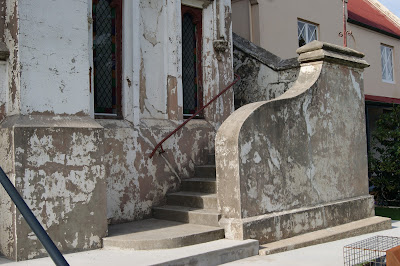In Tasmania, members of the Free Kirk made an appeal to the Assembly of the Free Church for a permanent minister and the Rev. James Lindsay was appointed on 7th December, 1850 and on January 19th 1859 the foundation stone of Chalmers Church was laid. The Rev. James Lindsay then proceeded to lay the stone, which was a massive block of freestone weighing about a tonne and a half.
Having deposited in a prepared cavity a bottle hermetically sealed, containing (The model Deed of Church The Free Church Protest of 1843, The Testimony of the Free Church Association, Launceston 1848, The Declaration of the Free Church Presbytery of Tasmania 1853, Royal Kalendar 1859, the local newspapers, Current coins and written parchment), the stone was lowered and adjusted into its place, and the customary ceremonial of the mallet was performed. Chalmers was officially opened on January 15th, 1860, by the Rev. William Nicholson of Chalmers Church, Hobart.
The architect was William Henry Clayton. William Henry Clayton was born on 17 November 1823, at Norfolk Plains, Van Diemen’s Land. He was one of 12 children of Henry Clayton and his wife, Mary McLaughlan. William was educated at the local Longford Hall Academy. Henry Clayton, a successful farmer and merchant, wanted his son to have the benefits of higher education, so the Clayton family sailed for England on 28 March 1840 on the Adelaide.
While in England William Clayton was articled to a prominent architect, and in the course of his architectural training he became proficient in surveying and civil engineering. On 7 October 1847, at Clapham, Surrey, William married Emily Samson. Soon after, the couple departed for Tasmania, arriving on 7 March 1848. William and Emily Clayton spent the next 15 years in Tasmania.
William soon achieved recognition as an architect. He designed over 300 buildings, including churches, mansions and commercial buildings. He was also employed by the Survey Department for four years from late 1851 to late 1855. William acquired status in community affairs. He was an alderman in Launceston from 1857 to 1863 and in 1858 was appointed a justice of the peace. Attracted by business opportunities arising from the success of the Otago goldfields, William Clayton emigrated to New Zealand, arriving at Dunedin on the Omeo on 29 April 1863.
By 1864 he had allied himself with William Mason, a well-established New Zealand architect; they practiced under the name of Mason and Clayton. Seven days after an amputation (from an infected ankle), on 23 August 1877, Clayton died. He was buried in Dunedin’s Northern cemetery the following day. He was only 53.
The church was named after Thomas Chalmers, the leader of the Great Disruption. The Scottish church reformer and theologian Thomas Chalmers was a central figure in the 1843 secession of the Free Church from the Presbyterian Establishment.
Thomas Chalmers was born in Fife on March 17, 1780. After Presbyterian ordination in 1803, he was a successful preacher and instructor. In 1823 Chalmers became professor of moral philosophy at St. Andrews. From 1828 to 1843 he was professor of theology at the University of Edinburgh, and during this period he wrote many of his 34 volumes of published works. But more important was his leadership of the reformers in the crisis over patronage in the Scottish Church.
At the annual Presbyterian General Assembly in 1832, with Chalmers as moderator, a proposal to change the patronage system failed. Finally, in May 1843, Chalmers regretfully led the famous secession of 470 ministers, who then began the Free Church of Scotland. As the first moderator, Chalmers raised substantial sums to finance the building of hundreds of new churches. From 1843 to 1847 he also served as principal of the Free Church’s New College. Chalmers died suddenly on May 31, 1847. It is said that half the population of Edinburgh attended his funeral.
Chalmers is a dazzling example of flamboyant Gothic Revival style. The Gothic features of Chalmers include; numerous arched windows, the steeped pitched roof and the magnificent Gothic style iron fence (which provides the boundary on the northern, eastern and partially on the western sides of the property) and are still retained today.
The ornate bell tower encompasses eight facemasks – presumably the face of John Knox, considered to be the greatest Reformer in the history of Scotland and of the Church of Scotland in the 1500s. High up in the dusty belfry you will find the original bell, cast in London by G. Mears Founder London 1859. It is said to weigh over a tonne.
In 1896 the church became part of the United Presbyterian Church, later to become the Uniting Church. The building, including the cast iron railings (designed by Clayton in England), is classified by the National Trust, is on the Register of the National Estate and is included in the Launceston National Estate Conservation Study. The Fincham organ, boxed pews, wooden dado and other church furnishings were removed in 1981.
In 1981 Chalmers was deconsecrated and bought by Trinity Projects, who planned to convert the building into four town houses. In 1986, it was bought by Launceston Players. By 1990 the building had been purchased privately by Ken and Juliet Partridge and then in 2011 it was purchased privately by Graeme and Jodie Walker. By 2014 renovations had been completed and Walker Designs had relocated to the site where they still conduct their business today.
Chalmers Church is a fascinating looking structure. The church's unique state of deterioration, a result of oil- based paint being mistakenly applied to the limestone and brick facade in 1976 trapping moisture beneath the paint so that it blistered and started to peel away, has made it one of Launceston's most recognizable sights and it would be interesting to see the building repainted and returned to its former glory.
Main Text, Information & Historical Photo –
More Historical Photos –
































